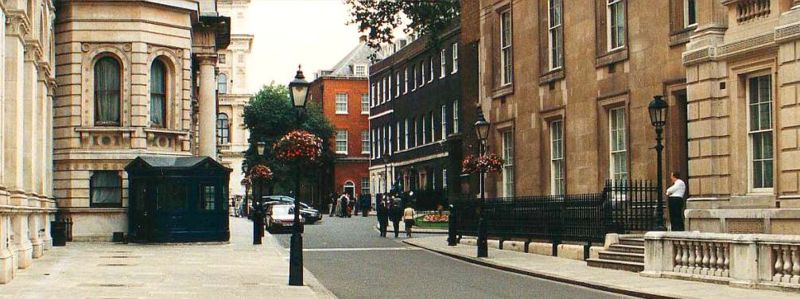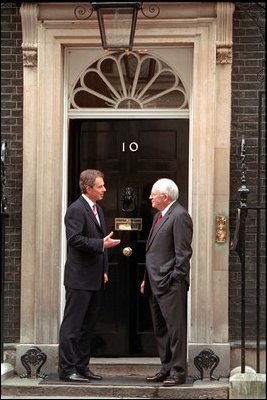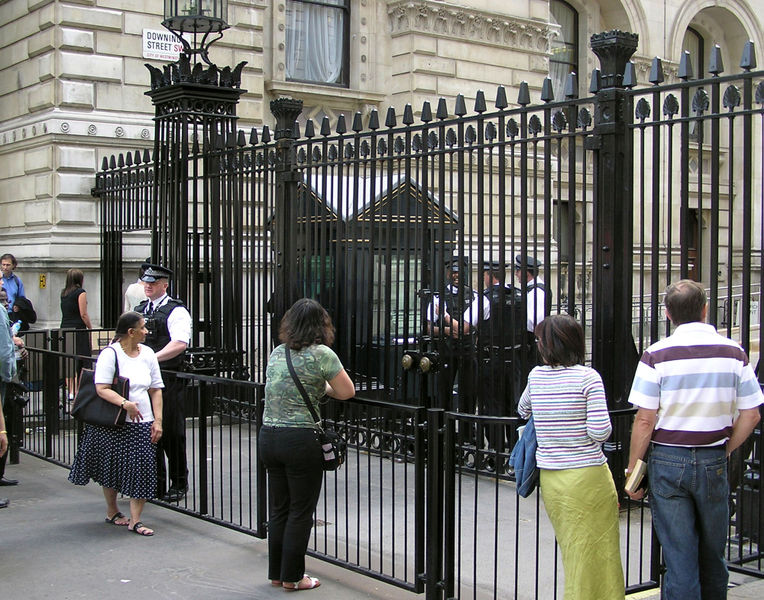|

|
|
Downing Street is the street in Westminster, London, which has been the official residence for 200 years of two of the most senior British Cabinet Ministers, the First Lord of the Treasury, an office held by the Prime Minister, and the Second Lord of the Treasury, an office held by the Chancellor of the Exchequer. The most famous address in Downing Street is 10 Downing Street, the official residence of the First Lord of the Treasury - and thus, in modern times, the residence of the Prime Minister, since the two roles have been filled by the same person. As a result of this "Downing Street" or "Number 10" is often used as short-hand for the Prime Ministers or their office, whilst "Number 11" is likewise a term for the Chancellors of the Exchequer or their office. Downing Street is located in Whitehall in central London, a few minutes' walk from the Houses of Parliament and on the edge of Horse Guards Parade and St. James's Park. The street was built by and named after Sir George Downing, 1st Baronet (1632 - 1689). Downing was a soldier and diplomat who served under Oliver Cromwell and King Charles II. In the service of the King he was rewarded with the plot of land adjoining St. James's Park upon which Downing Street now stands. The Prime Minister, the Chancellor of the Exchequer, and the Chief Whip all officially live in houses on one side of the street. According to the Downing Street official website, the last private resident in the street was a Mr Chicken, about whom very little is known except that he left Downing Street some time in the 1730s. The houses on the other side were all replaced by the massive Foreign Office in the nineteenth century. In the 1950s and 1960s, plans were considered to demolish both the Foreign Office and the rest of Downing Street and build "something more modern". However the plans were never implemented and have long since been abandoned. Who lives where
Throughout the history of the houses, ministers have lived by agreement in whatever rooms they thought appropriate. On some occasions Number 11 has been occupied not by the Chancellor of the Exchequer but by the individual considered to be the nominal deputy Prime Minister(whether or not they actually take the title)-this was particularly common in coalition governments. Sometimes a minister will only use their Downing Street flat for formal occasions and otherwise live elsewhere. During his period in office starting in 1881, William Gladstone claimed residence in numbers 10, 11 and 12 for himself and his family. This was reasonable since he was both Chancellor of the Exchequer and Prime Minister at the time. After the 1997 General Election in which Labour took power, a swap was carried out by the present incumbents of the two titles, Tony Blair being a married man with three children still living at home, whilst his counterpart, Gordon Brown, was unmarried at the time of taking up his post. Although Number 10 continued to be the prime minister's official residence and contain the prime ministerial offices, Blair and his family moved into the more spacious Number 11, while Brown lived in the more meagre apartments of Number 10. Downing Street gates
In 1989, large black steel gates were erected at the entrance of Downing Street to protect the Prime Minister (then Margaret Thatcher) from terrorist attack, particularly from the Provisional IRA. Before then it was possible for members of the public to walk through Downing Street and past Number 10, as a shortcut to St. James's Park. In 2003, work to strengthen the foundations of the gates was carried out. | ||||||||||||
|
See also
External link
|
||||||||||||
source: www.wikipedia.org |


